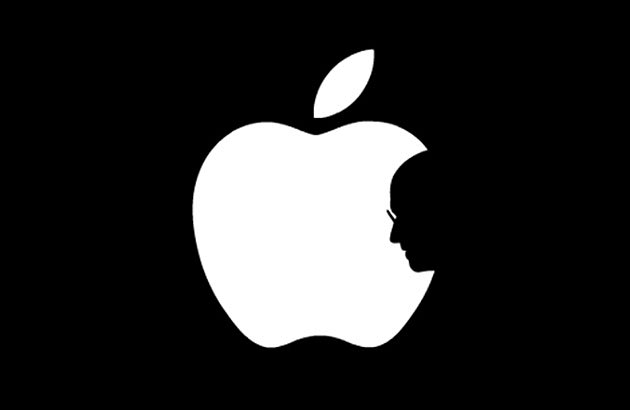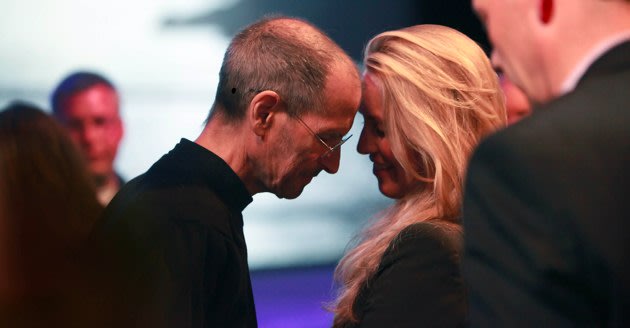 AFP
AFP
A Hong Kong design student said on Friday he was overwhelmed and felt "unreal" after his sombre logo in tribute to Apple founder Steve Jobs caused a worldwide Internet sensation.
The design, featuring Jobs's silhouette incorporated into the bite of
a white Apple logo on a black background, has gone viral on the
Internet since news of his death.
"I feel so unreal," Jonathan Mak, a second year graphic design student at Hong Kong Polytechnic University, told AFP, after he was inundated with tens of thousands of emails and messages on his Twitter account.
"You don't get to 180 thousands notes without feeling slightly
insane," the 19-year-old posted on another microblogging site Tumblr
Friday, referring to the messages he has received.
Mak said newspapers in the United States and Germany have contacted
him about buying the copyright to use his logo and had received job
offers.
"I am flattered by the attention but I would like to focus on my
study before taking on any full-time job," said the bespectacled
student, adding that he was trying to cope with his new-found fame.
"I'm quite busy now actually as I'm trying to finish a school project."
When asked about whether he would
be targeting commercial opportunities, Mak said he was considering
contacting Apple on copyright issues because his design is based on
Apple's own logo.
Some merchandisers have reportedly
used his logo for commemorative memorabilia for Jobs such as t-shirts
and caps that are being sold on the Internet.
"I will consider using any proceeds
I make from the copyright for cancer research, as suggested by some
people to me on the Internet," he said. Jobs died at 56 of pancreatic
cancer.
Mak said he first came up with the
design after Jobs announced his resignation in late August, but the logo
received little attention at the time.
The teenager said the Apple founder had inspired him in his design.
"He was a minimalist, which is the way I would like to emphasise in my design -- fewer elements but a powerful message."
"Steve Jobs strongly believed in
his own ideas and continued with his beliefs no matter how people
criticised him. He was courageous," said Mak.
When
Steve Jobs resigned from
Apple in August, 7,000 miles away in Hong Kong,
graphic design student Jonathan Mak Long, "shocked" by the CEO's departure, did what he knew best: He
created a design to honor the
Apple co-founder.
The 19-year-old posted the image, the Apple logo with the bite changed to a profile of
Jobs, to his
Tumblr blog. Known as
Jonathan Mak,
he initially received about 80 notes on the image. Then word came this
past Wednesday that Jobs had died, after a long battle with cancer. Mak
reposted the homage, which this time caught fire on the Web, attracting
an almost immediate response of 10,000 likes and reblogs on his Tumblr
site and surging to 180,000 -- in one day. Comments included "awesome
invention like steve jobs." One thought it should be the "new Apple
logo." Another wanted to "use it as a tattoo."
Speaking in fluent English (which he said he learned from watching the TV show "
Friends"), the
Polytechnic University School of Design student told
Yahoo!
in a Skype interview that the image was a tribute to Jobs's
contributions to the world: "I wanted to commemorate him. He's such an
integral part of Apple. I thought it would be fitting to include him in
the Apple logo." Long added, "With Jobs gone, Apple is literally missing
a piece."
The artist was inspired by the uncompromising personality of the
creative genius. He said of Jobs: "He had this vision that he was not
afraid to commit to. That's how he broke new ground. His commitment and
belief in himself is what inspire me." The designer's vision for his own
work is an aesthetic that joins a simple graphic element with a richer
meaning, giving the viewer, as he put it, an "a-ha moment."
The cyber tribute that became a hit, and along with attracting media
attention, the logo found itself as the preferred profile pic on
Ashton Kutcher's
Twitter account and on merchandise featured on eBay. While the design
prodigy has received several job offers, but he hasn't acted on them;
"I'm still a student," he said. The artist has a portfolio of minimalist
design, but don't call him an Apple fanboy. "I just got my first
MacBook Pro a year ago," he admitted -- and he still doesn't own an
iPhone.
Asked whether he'd gotten any response from Apple, Mak said he had emailed CEO
Tim Cook but so far hadn't heard back.
9 things you didn’t know about the life of Steve Jobs
By Taylor Hatmaker, Tecca | Today in Tech
For all of his years in the spotlight at the helm of
Apple,
Steve Jobs in many ways remains an inscrutable figure — even in his
death. Fiercely private, Jobs concealed most specifics about his
personal life, from his curious family life to the details of his battle
with pancreatic cancer — a disease that ultimately
claimed him on Wednesday, at the age of 56.
While the CEO and co-founder of Apple
steered most interviews away from the public fascination with his
private life, there's plenty we know about Jobs the person, beyond the
Mac and the iPhone. If anything, the obscure details of his interior
life paint a subtler, more nuanced portrait of how one of the finest
technology minds of our time grew into the dynamo that we
remember him as today.
Jobs was born in San Francisco on February 24, 1955. He was adopted
shortly after his birth and reared near Mountain View, California by a
couple named Clara and Paul Jobs. His adoptive father — a term that Jobs
openly objected to — was a machinist for a laser company and his mother
worked as an accountant.
Later in life, Jobs discovered the identities of his estranged
parents. His birth mother, Joanne Simpson, was a graduate student at the
time and later a speech pathologist; his biological father,
Abdulfattah John Jandali,
was a Syrian Muslim who left the country at age 18 and reportedly now
serves as the vice president of a Reno, Nevada casino. While Jobs
reconnected with Simpson in later years, he and his biological father
remained estranged.
2. College dropout
The lead mind behind the most successful company on the planet never
graduated from college, in fact, he didn't even get close. After
graduating from high school in Cupertino, California — a town now
synonymous with 1 Infinite Loop, Apple's headquarters — Jobs enrolled in
Reed College in 1972. Jobs stayed at Reed (a liberal arts university in
Portland, Oregon) for only one semester, dropping out quickly due to
the financial burden the private school's steep tuition placed on his
parents.
In his famous
2005 commencement speech
to Stanford University, Jobs said of his time at Reed: "It wasn't all
romantic. I didn't have a dorm room, so I slept on the floor in friends'
rooms, I returned coke bottles for the 5 cent deposits to buy food
with, and I would walk the seven miles across town every Sunday night to
get one good meal a week at the Hare Krishna temple."
3. Fibbed to his Apple co-founder about a job at Atari
Jobs is well known for his innovations in personal computing, mobile
tech, and software, but he also helped create one of the best known
video games of all-time. In 1975, Jobs was
tapped by Atari to work on the
Pong-like game
Breakout.
He was reportedly offered $750 for his development work, with the
possibility of an extra $100 for each chip eliminated from the game's
final design. Jobs recruited Steve Wozniak (later one of Apple's other
founders) to help him with the challenge. Wozniak managed to whittle the
prototype's design down so much that Atari paid out a $5,000 bonus —
but Jobs kept the bonus for himself, and paid his unsuspecting friend
only $375, according to Wozniak's own
autobiography.
4. The wife he leaves behind
Like the rest of his family life, Jobs kept his marriage out of the
public eye. Thinking back on his legacy conjures images of him
commanding the stage in his trademark black turtleneck and jeans, and
those solo moments are his most iconic. But at home in Palo Alto, Jobs
was raising a family with his wife, Laurene, an entrepreneur who
attended the University of Pennsylvania's prestigious Wharton business
school and later received her MBA at Stanford, where she first met her
future husband.
For all of his single-minded dedication to the company he built from the ground up, Jobs actually
skipped a meeting
to take Laurene on their first date: "I was in the parking lot with the
key in the car, and I thought to myself, 'If this is my last night on
earth, would I rather spend it at a business meeting or with this
woman?' I ran across the parking lot, asked her if she'd have dinner
with me. She said yes, we walked into town and we've been together ever
since."
In 1991, Jobs and Powell were married in the Ahwahnee Hotel at
Yosemite National Park, and the marriage was officiated by Kobin Chino, a
Zen Buddhist monk.
5. His sister is a famous author
Later in his life, Jobs crossed paths with his biological sister while
seeking the identity of his birth parents. His sister, Mona Simpson
(born Mona Jandali), is the well-known author of
Anywhere But Here — a story about a mother and daughter that was later adapted into a film starring Natalie Portman and Susan Sarandon.
After reuniting, Jobs and Simpson developed a close relationship. Of his sister, he told a
New York Times interviewer: "We're family. She's one of my best friends in the world. I call her and talk to her every couple of days.''
Anywhere But Here is dedicated to "my brother Steve."
6. Celebrity romances
In
The Second Coming of Steve Jobs, an unauthorized biography, a friend from Reed reveals that Jobs had a brief fling with folk singer Joan Baez. Baez
confirmed
the the two were close "briefly," though her romantic connection with
Bob Dylan is much better known (Dylan was the Apple icon's favorite
musician). The biography also notes that Jobs went out with actress
Diane Keaton briefly.
7. His first daughter
When he was 23, Jobs and his high school girlfriend Chris Ann Brennan
conceived a daughter, Lisa Brennan Jobs. She was born in 1978, just as
Apple began picking up steam in the tech world. He and Brennan never
married, and Jobs reportedly
denied paternity
for some time, going as far as stating that he was sterile in court
documents. He went on to father three more children with Laurene Powell.
After later mending their relationship, Jobs paid for his first
daughter's education at Harvard. She graduated in 2000 and now works as a
magazine writer.
8. Alternative lifestyle
In a few interviews, Jobs hinted at his early experience with the
psychedelic drug LSD. Of Microsoft founder Bill Gates, Jobs said: "I
wish him the best, I really do. I just think he and Microsoft are a bit
narrow. He'd be a broader guy if he had dropped acid once or gone off to
an ashram when he was younger."
The connection has enough weight that Albert Hofmann, the Swiss
scientist who first synthesized (and took) LSD, appealed to Jobs for
funding for research about the drug's therapeutic use.
In a
book interview,
Jobs called his experience with the drug "one of the two or three most
important things I have done in my life." As Jobs himself has suggested,
LSD may have contributed to the "think different" approach that still
puts Apple's designs a head above the competition.
Jobs will forever be a visionary, and his personal life also reflects
the forward-thinking, alternative approach that vaulted Apple to
success. During a trip to India, Jobs visited a well-known ashram and
returned to the U.S. as a
Zen Buddhist.
Jobs was also a pescetarian who didn't consume most animal products,
and didn't eat meat other than fish. A strong believer in Eastern
medicine, he sought to treat his own cancer through
alternative approaches and specialized diets before reluctantly seeking his first surgery for a cancerous tumor in 2004.
9. His fortune
As the CEO of the
world's most valuable brand,
Jobs pulled in a comically low annual salary of just $1. While the
gesture isn't unheard of in the corporate world — Google's Larry Page,
Sergey Brin, and Eric Schmidt all pocketed the same 100 penny salary
annually — Jobs has kept his salary at $1 since 1997, the year he became
Apple's lead executive. Of his salary, Jobs
joked in 2007: "I get 50 cents a year for showing up, and the other 50 cents is based on my performance."
In early 2011, Jobs owned 5.5 million shares of Apple. After his death, Apple shares were
valued at $377.64 — a roughly 43-fold growth in valuation over the last 10 years that shows no signs of slowing down.
He may only have taken in a single dollar per year, but Jobs leaves
behind a vast fortune. The largest chunk of that wealth is the roughly
$7 billion from the sale of Pixar to Disney
in 2006. In 2011, with an estimated net worth of $8.3 billion, he was the 110th richest person in the world, according to
Forbes.
If Jobs hadn't sold his shares upon leaving Apple in 1985 (before
returning to the company in 1996), he would be the world's fifth richest
individual.
While there's no word yet on plans for his estate, Jobs leaves behind
three children from his marriage to Laurene Jobs (Reed, Erin, and Eve),
as well as his first daughter, Lisa Brennan-Jobs.
Record thin on Steve Jobs’s philanthropy
For one of the nation’s most famous billionaires, Steve Jobs kept a low profile as a charitable donor.
Unlike fellow tech leaders Bill Gates and Mark Zuckerberg of Facebook, he did not sign the Giving Pledge, the effort under which the nation’s richest individuals commit to giving at least half their wealth to philanthropy.
Video
From tweeting teenagers to titans of
technology, millions around the world were mourning the passing of Apple
founder Steve Jobs Thursday. (Oct. 6)
 Steve Jobs’s death leaves Apple facing challenges
Steve Jobs’s death leaves Apple facing challenges
His name is absent from the list of gifts of $1 million or more maintained by Indiana University’s Center on Philanthropy.
And
it wasn’t until after an unflattering media report about Jobs on the
subject over the summer, that Apple in September initiated a “matching
gifts” program, under which donations to philanthropies made by
employees are matched by the company.
Now what will happen to
Jobs’s fortune — Forbes has estimated his net worth at $8.3 billion — is
a matter of speculation that is provoking discussion both about Jobs
and the societal obligations of the very rich.
The most recent
round of debate began after the New York Times published an unflattering
piece in August, stating “there is no public record of Mr. Jobs giving
money to charity.
. . . Nor is there a hospital wing or an academic building with his name on it.”
Moreover,
Jobs had closed Apple’s philanthropic programs when he returned to the
company in 1997 and never reinstated them despite $14 billion in profit
last year, the Times reported.
“Many other innovative companies
have found ways to apply their ingenuity and resources to helping
society,” Vincent Stehle, a longtime grantmaker in nonprofit technology
circles and a columnist for the Chronicle of Philanthropy, said
Thursday. “It was a little disappointing not to see Apple at the table.”
But
Jobs supporters note that the bulk of his contributions to society may
reside in the quality and innovation of Apple’s products. They also
pointed out ways that Jobs and Apple have been charitable.
Bono,
U2’s lead singer and a noted activist, quickly responded to the Times
piece, writing that “Apple’s contribution to our fight against AIDS in
Africa has been invaluable.”
The company had given “tens of
millions of dollars that have transformed the lives of more than two
million Africans through H.I.V. testing, treatment and counseling. This
is serious and significant. And Apple’s involvement has encouraged other
companies to step up,” Bono wrote. “Just because he’s been extremely
busy, that doesn’t mean that he and his wife, Laurene, have not been
thinking about these things.”
Jobs’s supporters say it also may be
impossible to know from public records what he gave away because he
could have requested anonymity. Indeed, his plans for the rest of his
wealth may not be known until well after his death.
The fact that
he doesn’t appear on lists of public giving “doesn’t necessarily mean
that he’s not giving generously,” said Adriene Davis of Indiana
University’s Center on Philanthropy, which tracks such gifts.
What may partly explain Jobs’s absence from the donor rolls is that he was so busy with his company.
Jobs’s
most direct effort at philanthropy was when he set up the Steven P.
Jobs Foundation, shortly after he was forced out of Apple in 1985. To
run that effort, he hired Mark Vermilion, who first spent time at
Humanitas International, a charity founded by Joan Baez, and then headed
Apple’s community efforts, which began when Vermilion proposed the
company give away computers to nonprofits.
Jobs wanted his
foundation to focus on nutrition and vegetarianism. Vermilion favored
programs that promoted social entrepreneurship. But then Jobs got
tied up building another company called NeXT and the foundation shut
down.
“I said, ‘You really need to spend some time on this’ and he
said ‘I can’t right now,’ ” Vermilion said. “I really don’t blame
Steve. I think I could have done a better job on selling him on my idea
or I should have done his idea.”
Had Jobs, who died at 56, lived
longer, he might have gotten around to more public charities, Vermilion
said, but because he was a perfectionist, he would have needed to devote
a lot of his scarce time to it.
“He’s gotten a lot of criticism
for not giving away tons of money,” Vermilion said. “But I think it’s a
bum rap. There’s only so many hours in a week, and he created so many
incredible products. He really contributed to culture and society.”


![Validate my Atom 1.0 feed [Valid Atom 1.0]](valid-atom.png)




































































 Steve
Jobs: 'Remembering that I'll be dead soon is the most important tool
I've ever encountered to help me make the big choices in life' (Photo:
PA)
Steve
Jobs: 'Remembering that I'll be dead soon is the most important tool
I've ever encountered to help me make the big choices in life' (Photo:
PA)








